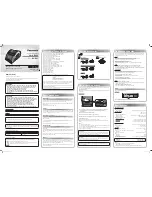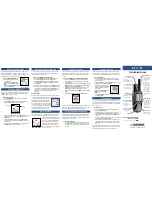
LINCE ITALIA S.p.A.
8
Il rilevatore è dotato di un apposito cavo a sei fili da utilizzare
per realizzare i collegamenti. Utilizzare i due cavi di diametro
maggiore per l’alimentazione, quindi dividere i quattro rimanenti
in due coppie: una per i collegamenti del TAMPER e l’altra per i
collegamenti ALARM.
Attenzione
: verificare se il trasmettitore gestisce ingressi NA
oppure NC (riferirsi al manuale del trasmettitore che si intende
installare). Collegare il cavo in dotazione ai morsetti denominati
POWER per portare l’alimentazione al rilevatore (si ricorda che
la tensione di ingresso può variare tra 3 e 9 Vcc).
Collegare i morsetti denominati ALARM per portare al
trasmettitore il segnale di allarme (NA oppure NC).
Collegare i cavetti provenienti dal microswith (nero C, bianco NA,
verde NC) al cavo in dotazione usando i morsetti TAMPER come
appoggio per portare al trasmettitore il segnale di sabotaggio.
NB:
per garantire il controllo dello stato di carica della batteria,
si onsiglia di alimentare il rilevatore con la stessa batteria del
trasmettitore e quindi non utilizzarne una dedicata.
7 FUNZIONE TEST
Tale funzione è stata implementata per facilitare la configurazione
del rilevatore.
Si può attivare questa funzione estraendo
e reinserendo il jumper
; entro un minuto la funzione verrà
attivata. In questa condizione i LED si attiveranno ed avranno il
seguente significato:
LED Rosso
: si accende ad ogni trasmissione radio sia essa un
sabotaggio che una rilevazione di allarme.
LED Verde sx
: si accende ogni qualvolta il PIR superiore rileva
un movimento.
LED Verde dx
: si accende ogni qualvolta il PIR inferiore rileva
un movimento.
Dopo 30÷40 secondi di quiete, entrare nell’area di rilevazione
quindi verificare il funzionamento del rilevatore con l’ausilio del
LED rosso di segnalazione allarme.
Una volta ottenuta la rilevazione, occorre attendere almeno
7÷8 secondi prima di provare ad essere rilevati di nuovo. Per
avere la cognizione dell’area protetta fare riferimento ai grafici di
copertura (fig. 10 – fig. 12 – fig. 13)
Dopo circa 4 minuti il rilevatore esce automaticamente dalla
modalità test, i LED vengono disattivati e viene attivata la
funzione di inibizione (vedi paragrafo 8 di seguito).
N.B.: Per provare la zona di copertura del rilevatore è
importante che il rilevatore sia chiuso e con il coperchio con
lente di Fresnel inserito.
Una volta effettuate le prove di rilevazione e copertura radio il
rilevatore è pronto per il funzionamento, al termine della fase
di test il funzionamento del rilevatore potrà essere verificato in
accordo con il sistema radio al quale è collegato.
NB: i LED saranno attivi esclusivamente quando il rilevatore
è in modalità test. Al termine del test i LED saranno disattivati,
per riattivarli al fine di verificare il funzionamento del
rilevatore occorre, rimuovere la copertura con lente estrarre
e reintrodurre il jumper quindi richiudere il coperchio con
lente.
8 INIBIZIONE
Nel funzionamento normale (LED spenti) il rilevatore attiva
automaticamente la funzione INIBIZIONE per risparmiare
batteria, questo comporta che, se l’ambiente è frequentato, il
rilevatore rimane inibito fino a quando non sussistano almeno 3
minuti di quiete (nessuna rilevazione).
Questa funzione evita che il rilevatore trasmetta di continuo
situazioni di allarme ad ogni passaggio di persone.
Use the two cables with bigger diameter to connect the power
supply, then make two couples with the other four wires to
connect respectively the TAMPER and the ALARM.
Attention
: verify which kind of signals the transmitter manages
(refer to the transmitter user’s manual in order to connect NO or
NA terminal block’s pin).
Connect the supplied cable to the power supply (remember that
the voltage input range is 3 - 9 Vdc).
Connect to the pin named ALARM to the input of the transmitter
in order to trigger the transmission with an event detection (NO
or NC).
Connect the wires coming from the microswitch (black C,
white NO, green NC) to the supplied cable (using the TAMPER
terminal block as support) in order to connect the detector to the
transmitter.
NB:
in order to ensure control of the state of charge of the
battery, it is advisable to feed the detector with the same
transmitter battery and therefore do not use one dedicated.
7 TEST FUNCTION
This function has been implemeted in order to make the detector
easy to set up.
The function can be activated disconnecting
and connecting again the jumper
; within a minute the function
will be operative. In this mode the LED will be lighted for each
detection. Below the meanings of the LED’s:
Red LED
: switch on when there is an alarm or tamper situation.
Green left LED
: switch on when the upper PIR detects a motion.
Green right LED
: switch on when the lower PIR detects a
motion.
After 30÷40 seconds without events, come in to the detection
area and, looking the red LED, verify if the detector works
correctly.
After the detection, wait at least 7÷8 seconds before the next
detection. Refer to the coverage diagram to estimate the
detection area (fig. 10 – fig. 12 – fig. 13).
After about 4 minutes the test mode is automatically switched off,
and the LED are deactivated (see paragraph 8).
Note: Be sure to have screwed up the cover with Fresnel
lens before perform the tests.
Once performed detection and radio transmission range tests,
the detector is ready to work, at the end of the test step, the
detector operation can be verified in accordance with the radio
system to which it is connected.
Note: LEDs are active only in test mode.
In working mode the LEDs are automatically deactivated. In
order to verify if the detector is working properly, remove
the front cover disocnnect and connect again the jumper
to activate the testing mode; at the end screw the cover up.
8 INHIBITION
In working mode (LEDs deactivated) the function INHIBITION is
automatically activated in order to safe battery life. This implies
that if the detector has been installed in a populated area, the
detector will no switch the alarm relay if the detection area is free
for three minutes at least.
This function avoid that the detector triggers the alarm relay






























